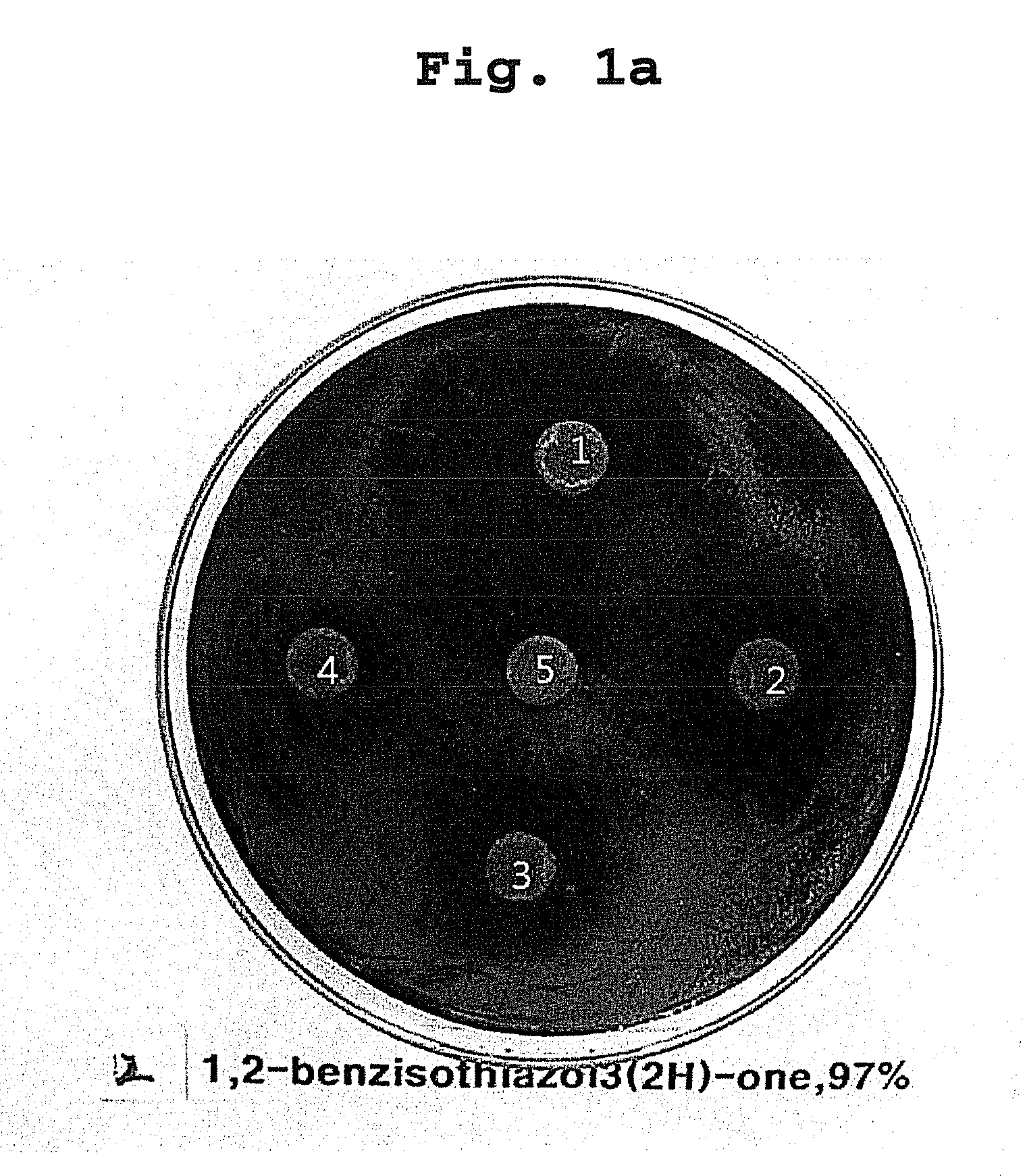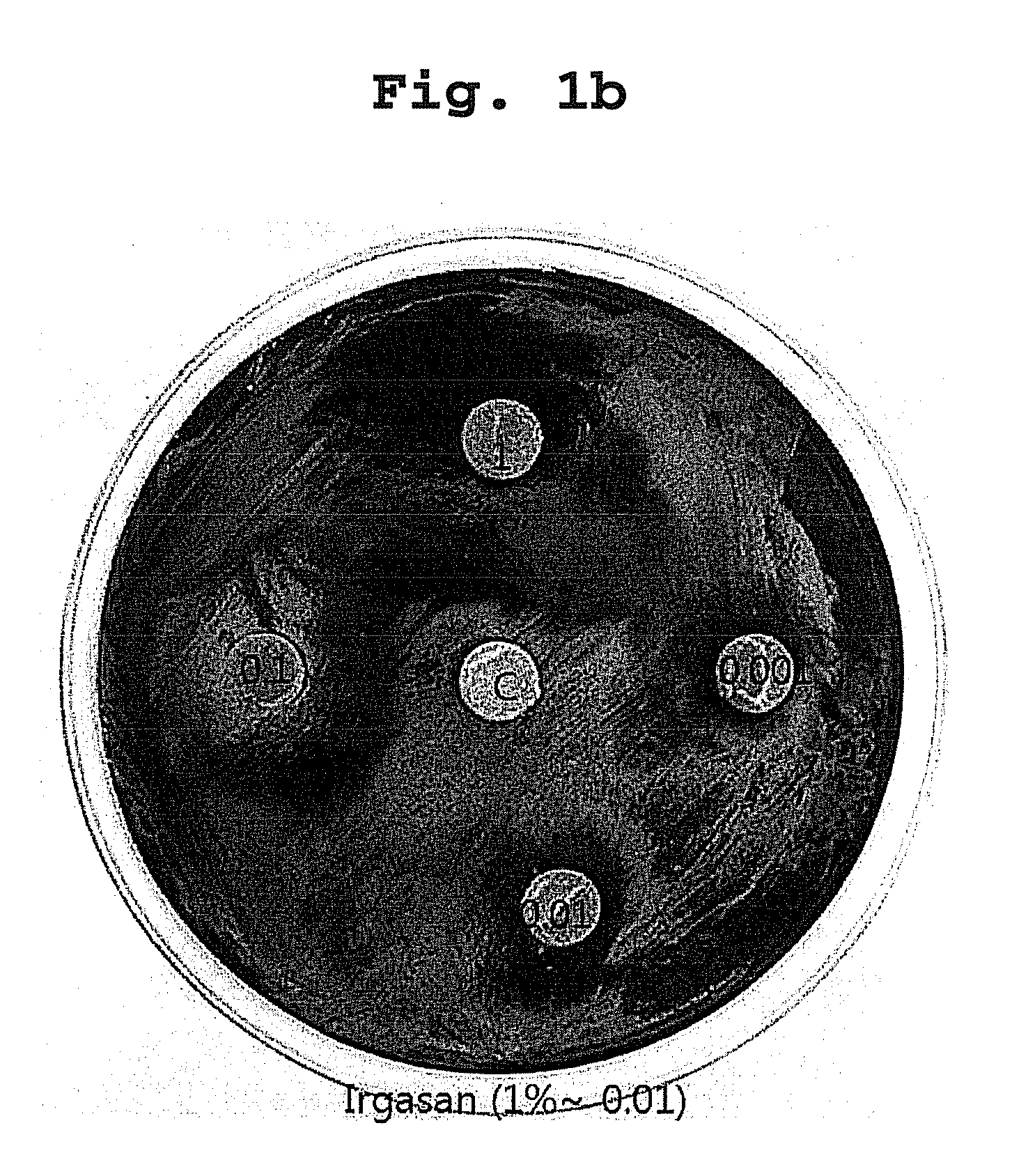Anti-sulphate reducing bacteria composition comprising 1,2-benzisothiazol-3(2H)-one, irgasan, benzyl-2-bromoacetate, 2,2-dibromo-2-cyanoacetamide, and 2-bromo-2-nitropropan-1,3-diol
- Summary
- Abstract
- Description
- Claims
- Application Information
AI Technical Summary
Benefits of technology
Problems solved by technology
Method used
Image
Examples
experiment example 1
Antibacterial Activity Evaluation
[0038]Desulfovibrio desulfuricans KCTC 5786 was used as a test sulphate reducing bacteria strain. The medium for culturing the bacteria was Desulfovibrio medium, and the composition of the medium was shown in Table 1:
TABLE 1Composition of Desulfovibrio mediumIngredientCompositionK2HPO40.5gNH4Cl1.0gNa2SO41.0gCaCl2•2H2O0.1gDL-Na-lactate2.0gYeast extract1.0gResazurin1.0mgFeSO4•7H2O0.5gNa-thioglycolate0.1gAscorbic acid0.1gDistilled water1,000ml
[0039]The all materials used in the test, disk paper, medium and so on, were sterilized for 15 min at 121° C. Bacteria's culture and antibacterial activity test were performed in an anaerobic chamber (Anaerobic System, Form a Sci; condition maintaining not more than 5 ppm of oxygen concentration).
[0040]After culturing the test strain for not less than 3 days, the volume of the culture was adjusted to 105-7 / mL to prepare for plating it on Desulfovibrio medium, and the test compounds were resolved in a suitable solve...
experiment example 2
Antibacterial Activity Test after Thermal Shock
[0043]Applying the heat shrinkable sheet using flames of torch, the temperature increased to about 150° C. and the exposure time was around 15 minutes. We would confirm that the organic antibacterial agent shows still the antibacterial activity even after being exposed to such temperature. After 1,2-benzisothiazol-3(2H)-one, irgasan, benzyl-2-bromoacetate, 2,2-dibromo-2-cyanoacetamide, and 2-bromo-2-nitropropan-1,3-diol were exposed to higher temperature (180° C.) for a longer time (1 hour), the antibacterial activity was measured at a concentration of 0.1% using the same method as Experiment Example 1 (see, Table 3, FIGS. 3a to 3e).
[0044]As a result, it was found that even after thermal shock, 1,2-benzisothiazol-3(2H)-one, irgasan, benzyl-2-bromoacetate, 2,2-dibromo-2-cyanoacetamide, and 2-bromo-2-nitropropan-1,3-diol maintained the excellent antibacterial activity, and the size of clear zone after thermal shock is was not almost diffe...
experiment example 3
Antibacterial Activity Test of Antibacterial Agent-Added Coating Material
[0045]Test equipment and materials, and test condition are as follows:[0046]Coating material type: adhesive (Canusa), primer (Polyken)[0047]Mixed antibacterial agent's concentration: control, 0.5, 1.0, 2.0, 5.0 wt %
[0048]As an adhesive specimen, the components were mixed by manual stirring in an oven at 150° C., and then an 1 mm-thick adhesive sheet was fabricated. As a primer specimen, a 0.2 mm-thick sheet having a primer dry film was fabricated. The specimen was diced into a size of 15 mm×15 mm, and after UV sterilization, the antibacterial activity of the specimen was assessed using the same environment and method as in the test method of Experiment Example 1 described above.
[0049]According to the experiment results, the antibacterial activity was observed in the adhesive regardless of the added antibacterial agent's concentration. In case that the antibacterial agent was added to the primer, although some i...
PUM
| Property | Measurement | Unit |
|---|---|---|
| Sensitivity | aaaaa | aaaaa |
| Heat | aaaaa | aaaaa |
Abstract
Description
Claims
Application Information
 Login to View More
Login to View More - R&D
- Intellectual Property
- Life Sciences
- Materials
- Tech Scout
- Unparalleled Data Quality
- Higher Quality Content
- 60% Fewer Hallucinations
Browse by: Latest US Patents, China's latest patents, Technical Efficacy Thesaurus, Application Domain, Technology Topic, Popular Technical Reports.
© 2025 PatSnap. All rights reserved.Legal|Privacy policy|Modern Slavery Act Transparency Statement|Sitemap|About US| Contact US: help@patsnap.com



